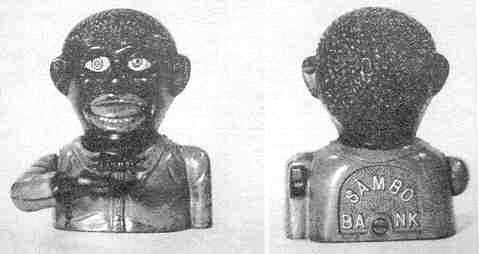Sambo Bank
by F.H. Griffith - HOBBIES Magazine - September, 1971

The writer is always particularly pleased when the occasion arises whereby he generally can inform readers of a new find in a mechanical bank. Well the Sambo Bank, necessarily No. 203 in the numerical classification at this point, comes into this category. Why Sambo has remained a more or less undiscovered bank for so long is just another one of those intriguing things that happens in connection with collecting mechanical banks. It could, of course, have something to do with the fact that from the front at least, see Figure 1, it certainly looks like Little Joe (HOBBIES, December, 1970) and, therefore, in a cursory fashion it could be mistaken for Little Joe. This does not explain why the bank has remained, generally speaking, undiscovered for so long a time. In any case, Sambo, like Little Joe, is of English manufacture and in the same time period.
The writer would like to explain that he has always had serious doubts as to there being an authentic Sambo Bank. This, however, was with respect to the larger size bust bank. He, over the years, has seen several Sambo Banks in the larger size, all with questionable authenticity. Certainly, it is possible that such a bank exists, but if it does, the writer has never seen one that could be considered an authentic original. There is no question, however, as to the authenticity of the smaller size Sambo Bank presently under discussion. Everything about it is right.
The bank shown, Figure 1 front view, Figure 2 back view, is in extra nice original condition. Colors are as follows: Face, hair and hand are black, lips and tongue are red, and teeth white. His white eyes have tan-orange pupils with black outlining and black centers. His shirt is red with yellow buttons and blue tie. Most important, see Figure 2, is the name ‘Sambo Bank’ in large yellow block letters. It is quite unique to have the name in a painted color other than gold.
The operation of the bank is the same as the majority of the bust type. Place a coin in the extended right hand, press the rear shoulder lever, and the hand lifts to the mouth. The coin slides therein as the tongue recedes and the eyes roll upward.
Normally the Sambo Bank would be attributed to John Harper, however, it has a very significant marking cast inside the back half. The letters ‘W.&.H.H.J.LD.’ appears incised in the casting. Research, still going on, has not as yet revealed what these letters represent with respect to the company that made the bank. Please understand that a possible connection with Harper has not been ruled out.
Now to the differences between Sambo and Little Joe. Of course, the outstanding difference is in the names. Second is the hand. Sambo has a separate thumb casting fastened to the hand, while Little Joe has a single unit hand casting including the thumb. The tongue of Little Joe is flat, while Sambo’s tongue is full and well rounded. The base plate on Little Joe is cast iron with no perforations. Sambo has an unusual cast iron plate with the front half only perforated. Then, of course, there are the initials cast inside Sambo which do not appear in Little Joe. Other than these noted differences, the banks are practically identical.
Sambo makes an interesting addition to the bust group of mechanicals, particularly so when grouped with Little Joe, Little Moe, and Little Hi-Hat, quite a combination of related (English) banks.
In closing the writer would like to bring attention to the fact that as of August 15, 1971, we have another mechanical bank that is in the 100-year-old category. This is the Horse Race Bank patented by John Hall, August 15, 1871, and made by J. & E. Stevens Company. For details on the bank see HOBBIES, March, 1959.
